Fuel Cell Technology: Innovation, Adoption & Challenges in Energy
VerifiedAdded on 2023/04/23
|6
|1454
|378
Case Study
AI Summary
This case study analyzes the potential of fuel cells in the energy industry, examining the dynamics of technological innovation, adoption strategies, and the challenges faced by early adopters. It highlights the history of fuel cell development, from early prototypes to current applications in stationary and mobile operations. The study discusses the economic and technical viability of fuel cells as a source of green energy, focusing on the hurdles in infrastructure development and the need for collaboration among manufacturers, consumers, and government entities. Furthermore, it explores advancements in fuel cell technologies, such as the use of solid carbon, and their potential future applications in transportation, stationary power, and portable devices. The conclusion emphasizes that widespread adoption of fuel cells requires significant investment in infrastructure and overcoming conflicts among stakeholders to fully realize the benefits of a hydrogen economy. Desklib provides access to similar case studies and solved assignments for students.

Running Head: TECHNOLOGICAL INNOVATION
Technological Innovation
Name of the Student
Name of the University
Author Note
Technological Innovation
Name of the Student
Name of the University
Author Note
Paraphrase This Document
Need a fresh take? Get an instant paraphrase of this document with our AI Paraphraser
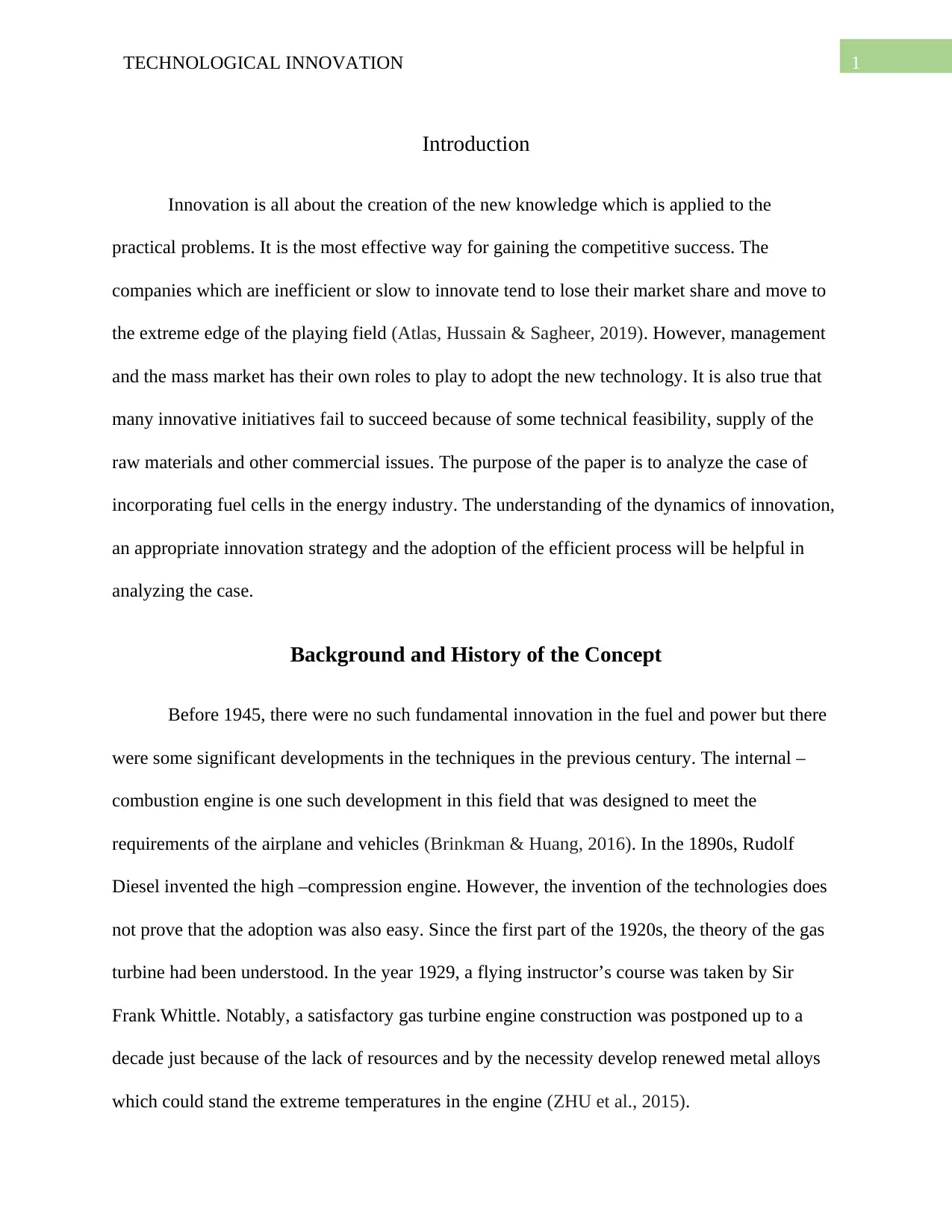
1TECHNOLOGICAL INNOVATION
Introduction
Innovation is all about the creation of the new knowledge which is applied to the
practical problems. It is the most effective way for gaining the competitive success. The
companies which are inefficient or slow to innovate tend to lose their market share and move to
the extreme edge of the playing field (Atlas, Hussain & Sagheer, 2019). However, management
and the mass market has their own roles to play to adopt the new technology. It is also true that
many innovative initiatives fail to succeed because of some technical feasibility, supply of the
raw materials and other commercial issues. The purpose of the paper is to analyze the case of
incorporating fuel cells in the energy industry. The understanding of the dynamics of innovation,
an appropriate innovation strategy and the adoption of the efficient process will be helpful in
analyzing the case.
Background and History of the Concept
Before 1945, there were no such fundamental innovation in the fuel and power but there
were some significant developments in the techniques in the previous century. The internal –
combustion engine is one such development in this field that was designed to meet the
requirements of the airplane and vehicles (Brinkman & Huang, 2016). In the 1890s, Rudolf
Diesel invented the high –compression engine. However, the invention of the technologies does
not prove that the adoption was also easy. Since the first part of the 1920s, the theory of the gas
turbine had been understood. In the year 1929, a flying instructor’s course was taken by Sir
Frank Whittle. Notably, a satisfactory gas turbine engine construction was postponed up to a
decade just because of the lack of resources and by the necessity develop renewed metal alloys
which could stand the extreme temperatures in the engine (ZHU et al., 2015).
Introduction
Innovation is all about the creation of the new knowledge which is applied to the
practical problems. It is the most effective way for gaining the competitive success. The
companies which are inefficient or slow to innovate tend to lose their market share and move to
the extreme edge of the playing field (Atlas, Hussain & Sagheer, 2019). However, management
and the mass market has their own roles to play to adopt the new technology. It is also true that
many innovative initiatives fail to succeed because of some technical feasibility, supply of the
raw materials and other commercial issues. The purpose of the paper is to analyze the case of
incorporating fuel cells in the energy industry. The understanding of the dynamics of innovation,
an appropriate innovation strategy and the adoption of the efficient process will be helpful in
analyzing the case.
Background and History of the Concept
Before 1945, there were no such fundamental innovation in the fuel and power but there
were some significant developments in the techniques in the previous century. The internal –
combustion engine is one such development in this field that was designed to meet the
requirements of the airplane and vehicles (Brinkman & Huang, 2016). In the 1890s, Rudolf
Diesel invented the high –compression engine. However, the invention of the technologies does
not prove that the adoption was also easy. Since the first part of the 1920s, the theory of the gas
turbine had been understood. In the year 1929, a flying instructor’s course was taken by Sir
Frank Whittle. Notably, a satisfactory gas turbine engine construction was postponed up to a
decade just because of the lack of resources and by the necessity develop renewed metal alloys
which could stand the extreme temperatures in the engine (ZHU et al., 2015).
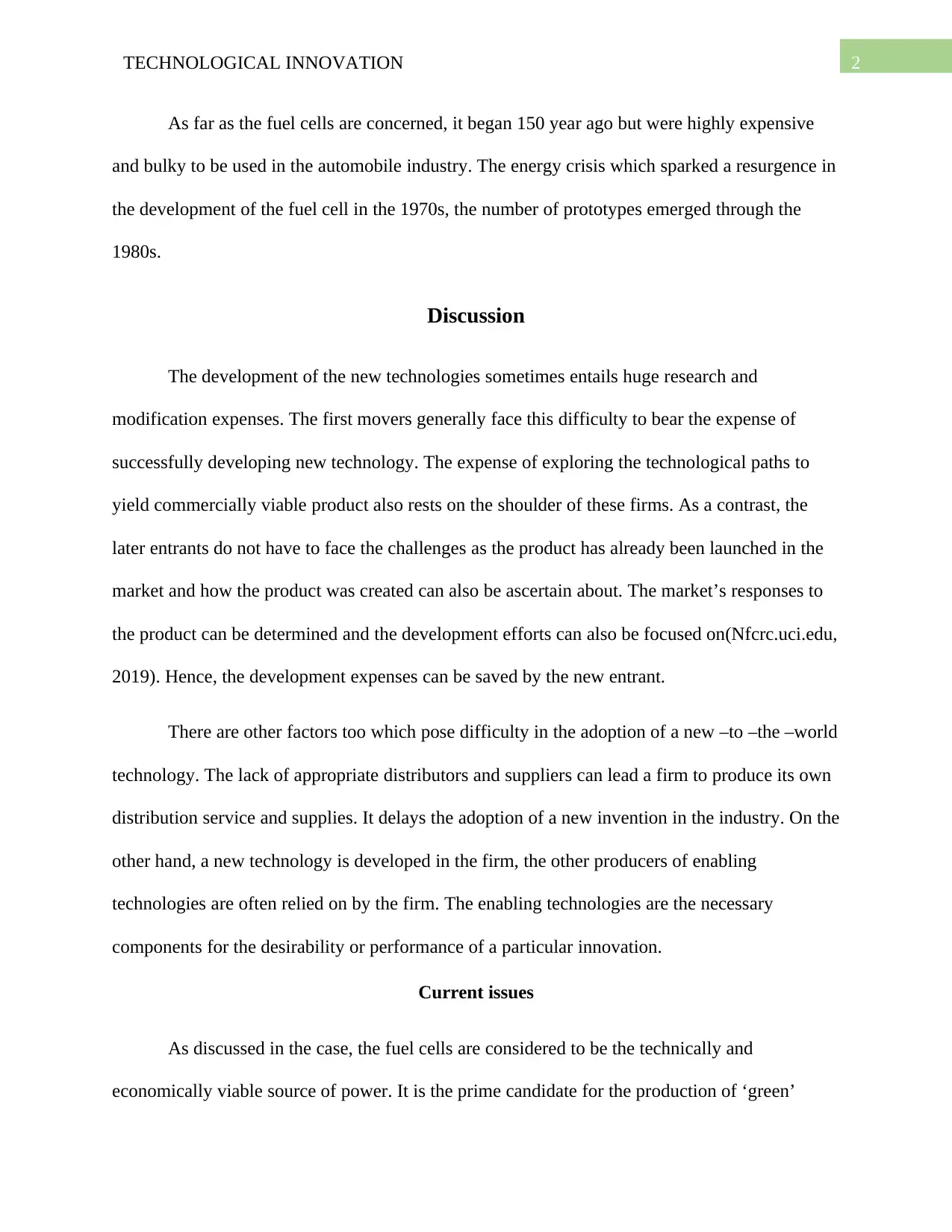
2TECHNOLOGICAL INNOVATION
As far as the fuel cells are concerned, it began 150 year ago but were highly expensive
and bulky to be used in the automobile industry. The energy crisis which sparked a resurgence in
the development of the fuel cell in the 1970s, the number of prototypes emerged through the
1980s.
Discussion
The development of the new technologies sometimes entails huge research and
modification expenses. The first movers generally face this difficulty to bear the expense of
successfully developing new technology. The expense of exploring the technological paths to
yield commercially viable product also rests on the shoulder of these firms. As a contrast, the
later entrants do not have to face the challenges as the product has already been launched in the
market and how the product was created can also be ascertain about. The market’s responses to
the product can be determined and the development efforts can also be focused on(Nfcrc.uci.edu,
2019). Hence, the development expenses can be saved by the new entrant.
There are other factors too which pose difficulty in the adoption of a new –to –the –world
technology. The lack of appropriate distributors and suppliers can lead a firm to produce its own
distribution service and supplies. It delays the adoption of a new invention in the industry. On the
other hand, a new technology is developed in the firm, the other producers of enabling
technologies are often relied on by the firm. The enabling technologies are the necessary
components for the desirability or performance of a particular innovation.
Current issues
As discussed in the case, the fuel cells are considered to be the technically and
economically viable source of power. It is the prime candidate for the production of ‘green’
As far as the fuel cells are concerned, it began 150 year ago but were highly expensive
and bulky to be used in the automobile industry. The energy crisis which sparked a resurgence in
the development of the fuel cell in the 1970s, the number of prototypes emerged through the
1980s.
Discussion
The development of the new technologies sometimes entails huge research and
modification expenses. The first movers generally face this difficulty to bear the expense of
successfully developing new technology. The expense of exploring the technological paths to
yield commercially viable product also rests on the shoulder of these firms. As a contrast, the
later entrants do not have to face the challenges as the product has already been launched in the
market and how the product was created can also be ascertain about. The market’s responses to
the product can be determined and the development efforts can also be focused on(Nfcrc.uci.edu,
2019). Hence, the development expenses can be saved by the new entrant.
There are other factors too which pose difficulty in the adoption of a new –to –the –world
technology. The lack of appropriate distributors and suppliers can lead a firm to produce its own
distribution service and supplies. It delays the adoption of a new invention in the industry. On the
other hand, a new technology is developed in the firm, the other producers of enabling
technologies are often relied on by the firm. The enabling technologies are the necessary
components for the desirability or performance of a particular innovation.
Current issues
As discussed in the case, the fuel cells are considered to be the technically and
economically viable source of power. It is the prime candidate for the production of ‘green’
⊘ This is a preview!⊘
Do you want full access?
Subscribe today to unlock all pages.

Trusted by 1+ million students worldwide
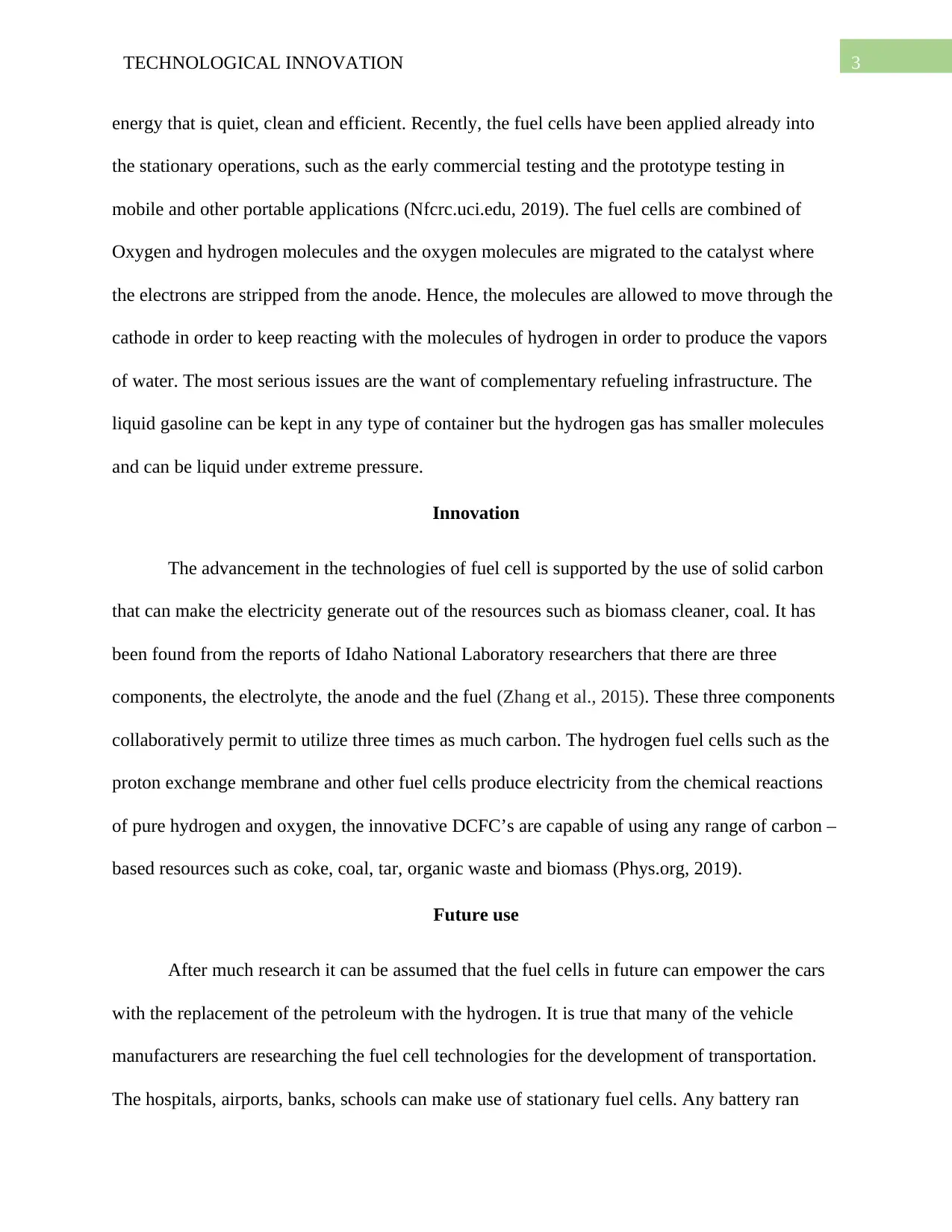
3TECHNOLOGICAL INNOVATION
energy that is quiet, clean and efficient. Recently, the fuel cells have been applied already into
the stationary operations, such as the early commercial testing and the prototype testing in
mobile and other portable applications (Nfcrc.uci.edu, 2019). The fuel cells are combined of
Oxygen and hydrogen molecules and the oxygen molecules are migrated to the catalyst where
the electrons are stripped from the anode. Hence, the molecules are allowed to move through the
cathode in order to keep reacting with the molecules of hydrogen in order to produce the vapors
of water. The most serious issues are the want of complementary refueling infrastructure. The
liquid gasoline can be kept in any type of container but the hydrogen gas has smaller molecules
and can be liquid under extreme pressure.
Innovation
The advancement in the technologies of fuel cell is supported by the use of solid carbon
that can make the electricity generate out of the resources such as biomass cleaner, coal. It has
been found from the reports of Idaho National Laboratory researchers that there are three
components, the electrolyte, the anode and the fuel (Zhang et al., 2015). These three components
collaboratively permit to utilize three times as much carbon. The hydrogen fuel cells such as the
proton exchange membrane and other fuel cells produce electricity from the chemical reactions
of pure hydrogen and oxygen, the innovative DCFC’s are capable of using any range of carbon –
based resources such as coke, coal, tar, organic waste and biomass (Phys.org, 2019).
Future use
After much research it can be assumed that the fuel cells in future can empower the cars
with the replacement of the petroleum with the hydrogen. It is true that many of the vehicle
manufacturers are researching the fuel cell technologies for the development of transportation.
The hospitals, airports, banks, schools can make use of stationary fuel cells. Any battery ran
energy that is quiet, clean and efficient. Recently, the fuel cells have been applied already into
the stationary operations, such as the early commercial testing and the prototype testing in
mobile and other portable applications (Nfcrc.uci.edu, 2019). The fuel cells are combined of
Oxygen and hydrogen molecules and the oxygen molecules are migrated to the catalyst where
the electrons are stripped from the anode. Hence, the molecules are allowed to move through the
cathode in order to keep reacting with the molecules of hydrogen in order to produce the vapors
of water. The most serious issues are the want of complementary refueling infrastructure. The
liquid gasoline can be kept in any type of container but the hydrogen gas has smaller molecules
and can be liquid under extreme pressure.
Innovation
The advancement in the technologies of fuel cell is supported by the use of solid carbon
that can make the electricity generate out of the resources such as biomass cleaner, coal. It has
been found from the reports of Idaho National Laboratory researchers that there are three
components, the electrolyte, the anode and the fuel (Zhang et al., 2015). These three components
collaboratively permit to utilize three times as much carbon. The hydrogen fuel cells such as the
proton exchange membrane and other fuel cells produce electricity from the chemical reactions
of pure hydrogen and oxygen, the innovative DCFC’s are capable of using any range of carbon –
based resources such as coke, coal, tar, organic waste and biomass (Phys.org, 2019).
Future use
After much research it can be assumed that the fuel cells in future can empower the cars
with the replacement of the petroleum with the hydrogen. It is true that many of the vehicle
manufacturers are researching the fuel cell technologies for the development of transportation.
The hospitals, airports, banks, schools can make use of stationary fuel cells. Any battery ran
Paraphrase This Document
Need a fresh take? Get an instant paraphrase of this document with our AI Paraphraser
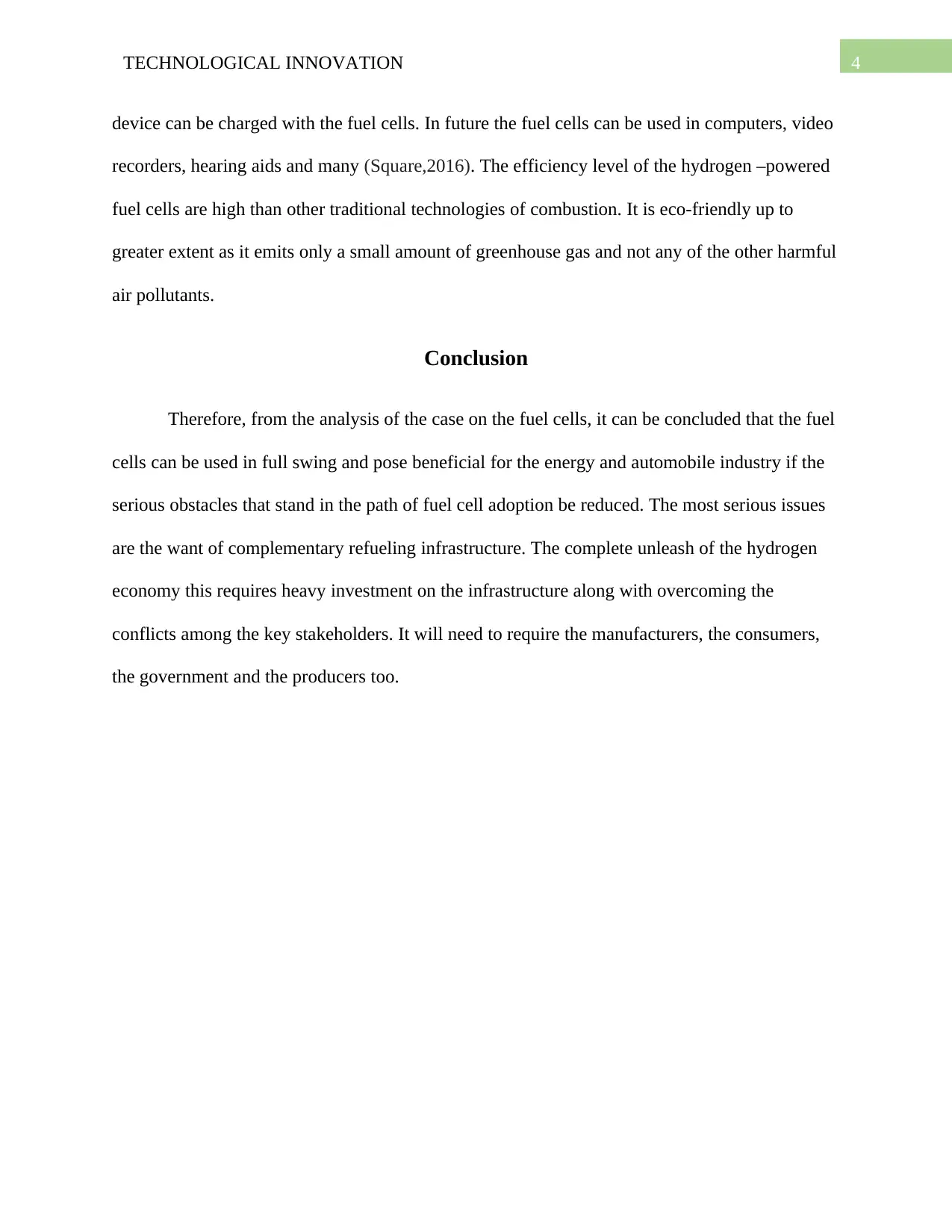
4TECHNOLOGICAL INNOVATION
device can be charged with the fuel cells. In future the fuel cells can be used in computers, video
recorders, hearing aids and many (Square,2016). The efficiency level of the hydrogen –powered
fuel cells are high than other traditional technologies of combustion. It is eco-friendly up to
greater extent as it emits only a small amount of greenhouse gas and not any of the other harmful
air pollutants.
Conclusion
Therefore, from the analysis of the case on the fuel cells, it can be concluded that the fuel
cells can be used in full swing and pose beneficial for the energy and automobile industry if the
serious obstacles that stand in the path of fuel cell adoption be reduced. The most serious issues
are the want of complementary refueling infrastructure. The complete unleash of the hydrogen
economy this requires heavy investment on the infrastructure along with overcoming the
conflicts among the key stakeholders. It will need to require the manufacturers, the consumers,
the government and the producers too.
device can be charged with the fuel cells. In future the fuel cells can be used in computers, video
recorders, hearing aids and many (Square,2016). The efficiency level of the hydrogen –powered
fuel cells are high than other traditional technologies of combustion. It is eco-friendly up to
greater extent as it emits only a small amount of greenhouse gas and not any of the other harmful
air pollutants.
Conclusion
Therefore, from the analysis of the case on the fuel cells, it can be concluded that the fuel
cells can be used in full swing and pose beneficial for the energy and automobile industry if the
serious obstacles that stand in the path of fuel cell adoption be reduced. The most serious issues
are the want of complementary refueling infrastructure. The complete unleash of the hydrogen
economy this requires heavy investment on the infrastructure along with overcoming the
conflicts among the key stakeholders. It will need to require the manufacturers, the consumers,
the government and the producers too.
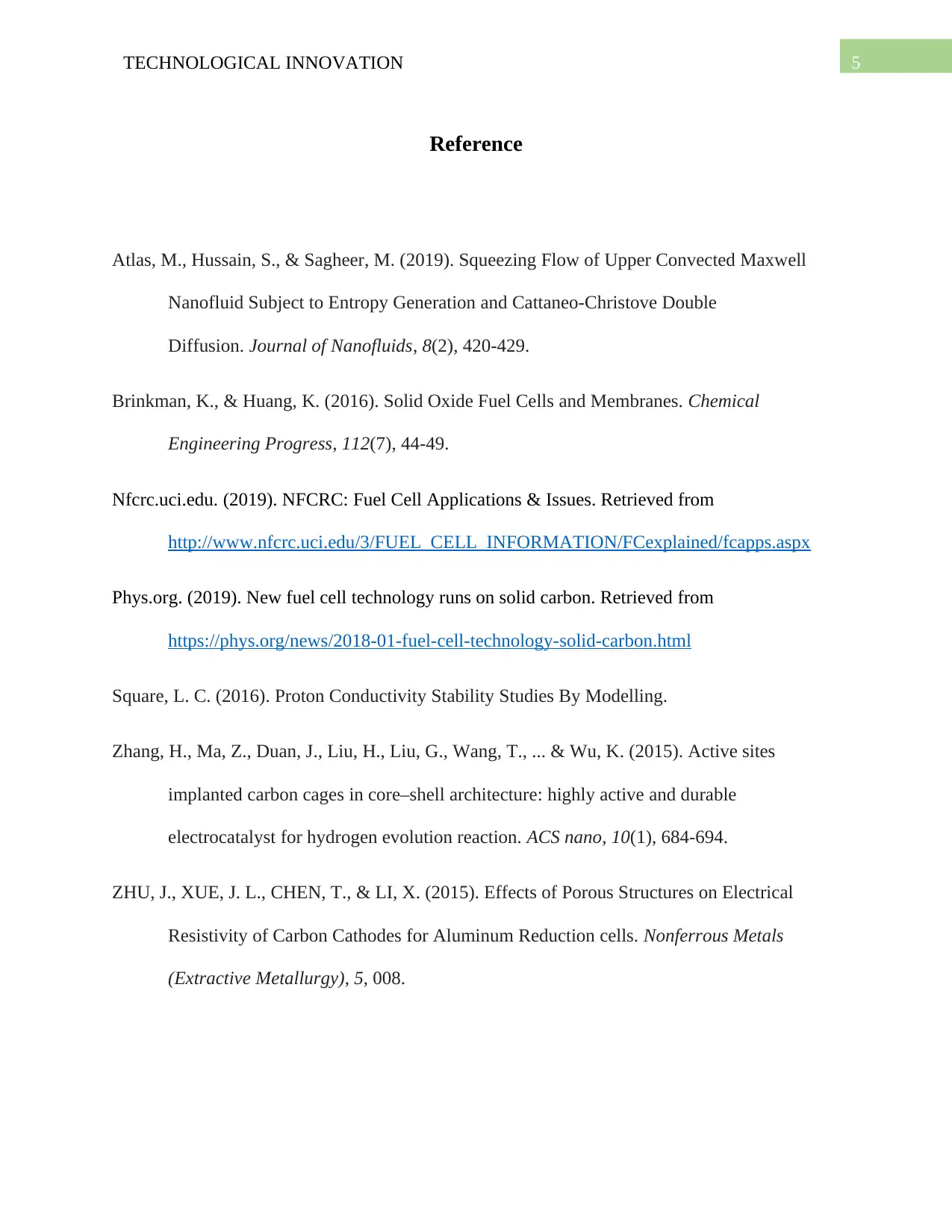
5TECHNOLOGICAL INNOVATION
Reference
Atlas, M., Hussain, S., & Sagheer, M. (2019). Squeezing Flow of Upper Convected Maxwell
Nanofluid Subject to Entropy Generation and Cattaneo-Christove Double
Diffusion. Journal of Nanofluids, 8(2), 420-429.
Brinkman, K., & Huang, K. (2016). Solid Oxide Fuel Cells and Membranes. Chemical
Engineering Progress, 112(7), 44-49.
Nfcrc.uci.edu. (2019). NFCRC: Fuel Cell Applications & Issues. Retrieved from
http://www.nfcrc.uci.edu/3/FUEL_CELL_INFORMATION/FCexplained/fcapps.aspx
Phys.org. (2019). New fuel cell technology runs on solid carbon. Retrieved from
https://phys.org/news/2018-01-fuel-cell-technology-solid-carbon.html
Square, L. C. (2016). Proton Conductivity Stability Studies By Modelling.
Zhang, H., Ma, Z., Duan, J., Liu, H., Liu, G., Wang, T., ... & Wu, K. (2015). Active sites
implanted carbon cages in core–shell architecture: highly active and durable
electrocatalyst for hydrogen evolution reaction. ACS nano, 10(1), 684-694.
ZHU, J., XUE, J. L., CHEN, T., & LI, X. (2015). Effects of Porous Structures on Electrical
Resistivity of Carbon Cathodes for Aluminum Reduction cells. Nonferrous Metals
(Extractive Metallurgy), 5, 008.
Reference
Atlas, M., Hussain, S., & Sagheer, M. (2019). Squeezing Flow of Upper Convected Maxwell
Nanofluid Subject to Entropy Generation and Cattaneo-Christove Double
Diffusion. Journal of Nanofluids, 8(2), 420-429.
Brinkman, K., & Huang, K. (2016). Solid Oxide Fuel Cells and Membranes. Chemical
Engineering Progress, 112(7), 44-49.
Nfcrc.uci.edu. (2019). NFCRC: Fuel Cell Applications & Issues. Retrieved from
http://www.nfcrc.uci.edu/3/FUEL_CELL_INFORMATION/FCexplained/fcapps.aspx
Phys.org. (2019). New fuel cell technology runs on solid carbon. Retrieved from
https://phys.org/news/2018-01-fuel-cell-technology-solid-carbon.html
Square, L. C. (2016). Proton Conductivity Stability Studies By Modelling.
Zhang, H., Ma, Z., Duan, J., Liu, H., Liu, G., Wang, T., ... & Wu, K. (2015). Active sites
implanted carbon cages in core–shell architecture: highly active and durable
electrocatalyst for hydrogen evolution reaction. ACS nano, 10(1), 684-694.
ZHU, J., XUE, J. L., CHEN, T., & LI, X. (2015). Effects of Porous Structures on Electrical
Resistivity of Carbon Cathodes for Aluminum Reduction cells. Nonferrous Metals
(Extractive Metallurgy), 5, 008.
⊘ This is a preview!⊘
Do you want full access?
Subscribe today to unlock all pages.

Trusted by 1+ million students worldwide
1 out of 6
Related Documents
Your All-in-One AI-Powered Toolkit for Academic Success.
+13062052269
info@desklib.com
Available 24*7 on WhatsApp / Email
![[object Object]](/_next/static/media/star-bottom.7253800d.svg)
Unlock your academic potential
Copyright © 2020–2025 A2Z Services. All Rights Reserved. Developed and managed by ZUCOL.





